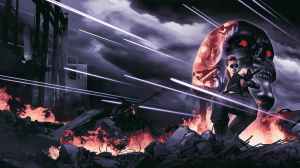
I. Love. Westerns.
Videos by ComicBook.com
Seriously, I was raised watching Westerns alongside my dad in the basement, specifically those with Clint Eastwood. Everything from Sergio Leone’s “The Man With No Name” trilogy to Paint Your Wagon could be found regularly on the television. He still hangs an original Italian poster of The Good, The Bad, and The Ugly (or Il Buono, Il Brutto, Il Cattivo) in his den, despite my best attempts to steal it for my own.
But that love hasn’t blinded me to the reality of the Western, specifically Western films, within American pop culture. During the 1950s and 1960s this genre was king, debuting dozens of new films each year to increasing popularity and with increasing variety. That trend began to turn in the 1970s though, resulting in a film landscape where Westerns are an oddity rather than a standard fare. While the influence of this genre can be seen everywhere, it is far more difficult to find.
The past decade American cinema has seen a surging popularity within another uniquely American genre: the superhero. 13 years after Spider-Man broke box office records and 8 years after Marvel Studios debuted Iron Man, superhero movies have grown to be the largest financial force in Hollywood bringing in billions of dollars each year, occasionally from a single release. Studios don’t appear to be interested in slowing that growth either. In addition to very full rosters of movies coming from Marvel Studios, Warner Brothers, and Fox, Sony is looking to increase their presence beyond a shared Spider-Man franchise and bring Valiant heroes to the big screen as well.
This increasing popularity has spawned a litany of think pieces concerning the inevitable downfall of the superhero genre at publications of all sorts and sizes. In fact, comparisons between the current surge of superhero movies and Westerns have become quite populous. It’s easy to see how someone might see them as being parallels (American genres, largely funded by Hollywood, mainstream entertainment value), but that doesn’t make them valid. In fact, there are some basic differences that make it clear the superhero genre has large-scale staying power in movie theaters that the Western never possessed.

If I had to attribute the decline of the Western to one thing, it would be its natural limitations. Over the course of two decades, Americans watch the Western explore a wide variety of terrain from Sergio Leone’s nihilistic reveries to John Ford’s exploration of American identity to Joshua Logan’s musical comedies. Yet it was situated in the same terrain. The Western is an inherently American genre; it’s in the name!
While there’s a wide variety of directorial styles and themes to be discovered in Westerns, they are all tied to the American frontier composed of great plains, expansive deserts, and gold-rich mountains. That setting is incredibly valuable when it comes to exploring standard Western themes. Exploration, violence, loneliness, and American values can all be panned from this river with ease. That’s why they tend to surface even in stories only tangentially connected to the genre like Firefly and Preacher. But it’s also a relatively specific focus, especially when compared to genres like science fiction and historical dramas that provide tools to explore almost any concept.
Those themes are important to why the Western came to popularity when it did. The Cold War defined the 1950s and 1960s, placing the confrontation between American and Soviet values at the forefront of everyone’s mind. The competing ideologies and consciousness of these two nations can be easily seen within the films they produced. American cinema invited its viewers to examine and appreciate individualism, personal freedoms, and expansionism. As the Cold War slowly began to warm in the 1970s and 1980s, the Western was no longer necessary to reassure audiences of what they were fighting for.
Those limitations and ties aren’t found within the superhero genre. While audiences who have only been exposed to superheroes through movies may see them all as being very similar, comics readers know that not to be the case. The majority of superhero movies still feature a basic formula of an origin that grants powers, the addition of a costume, and battles with evil, powered nemeses. Marvel Studios’ movies have presented a platonic ideal of the superhero genre, but that baseline allows for incredible changes to be made in a variety of different directions.
Just take a brief glance at the superhero comics that populate the walls of comic stores to see how much variety there is. There are small coming of age tales like the newly launched Plutona and bloody examinations of violence and the role of soldiers like Valiant’s Bloodshot Reborn. Even mainstream fare like Batman is exploring non-standard terrain like the role of police in confronting urban decay.
We’ve even begun to see this sort of growth in superhero movies. Small superhero movies like Chronicle have worked to deconstruct superhero tropes, while Christopher Nolan’s Batman films used the genre to explore political themes. Even Marvel Studios has shown an increased interest in breaking the mold. Ant-Man included a very trippy scene in its climax, and studio president Kevin Feige has promised things will only get weirder in Doctor Strange. In many ways, the superhero genre has only begun to show what its range in theaters.
That range also opens superhero movies to explore any theme they desire. While topics of power, violence, and identity immediately come to mind when thinking about superheroes, they are not the only easily accessible concepts. Returning again to the comics from which so many of these movies pull material, it’s possible to find a range of stories so broad in thematic material that it’s impossible to find any significant gaps.

I love superhero movies. I love Westerns. But the truth is they aren’t the same thing, and they aren’t bound to follow the same pop culture path. There’s really no reason to look at superhero movies and think they’re bound to take a tumble, not when they’re still raking in dollars and being met with incredible amounts of enthusiasm. Any comparisons between these two are just a weak attempt to backup what is essentially Chicken Little screaming about the sky falling. Looking ahead to the future of superhero movies, it’s much easier to see a genre that becomes increasingly diverse. A wider selection of themes, characters, and worlds won’t lead to the end of the superhero in movie theaters, but the increasing normalization of the genre. Superheroes aren’t going anywhere.
Don’t forget to check out Westerns when they do appear in theaters though. They may not be as popular as they were in the 60s, but I still love them.








